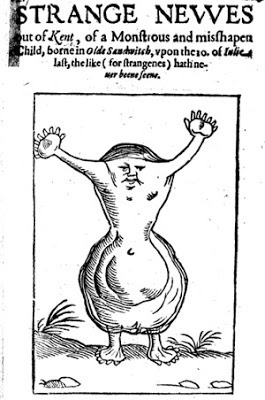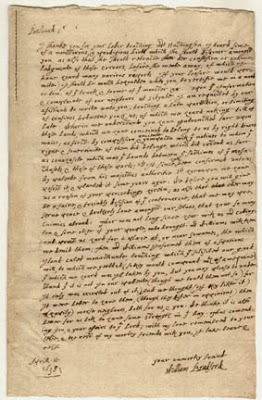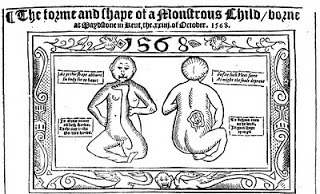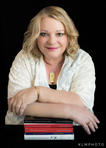Why the Pilgrim governor wanted to know about the Dyer “monster”
© 2013 Christy K Robinson
In October 1637, Mary Dyer gave birth to a premature, stillborn girl, which, according to descriptions, was an anencephalic (lacking more than a brainstem) and probably had spina bifida (neural tube defects). (See link to my article at the end.) This was the first anencephalic baby ever reported in America.
 Drawing depicts an anencephalic child born in England,
Drawing depicts an anencephalic child born in England,
but not Mary Dyer's child.
It had no head, nor any sign or proportion thereof,
there only appeared as it were two faces,
the one visibly to be seen, directly placed in the breast,
where it had a nose, and a mouth, and two holes
for two eyes, but no eyes, all which seemed ugly,
and most horrible to be seen, and much offensive
to human nature to be looked upon,
the other face was not perfectly to be seen,
but retained a proportion of flesh in a great round lump,
like unto a face quite disfigured, and this was
all of that which could be discerned.
The face, mouth, eyes, nose, and breast,
being thus framed together like a deformed piece of flesh,
resembled no proportion of nature, but seemed
as it were a chaos of confusion,
a mixture of things without any description...
Back in their native country, England, gravely-deformed babies were called “monsters” or “monstrous births,” and were commonly known to be heaven-sent proof of heresy or monstrous religious or political beliefs of the mother.
Mary’s unnamed daughter’s birth deformities and burial place were kept a secret among a handful of people. But in March 1638, at Anne Hutchinson’s heresy trial and conviction in Boston, Massachusetts, Anne was excommunicated and sentenced to leave the church and colony. Anne’s and Mary’s husbands were not at the trial, because they were preparing their newly-purchased land in Pocasset, on Rhode Island, for their impending move. When Anne was told to depart the meeting house, Mary stood up, took Anne’s hand, and they walked out together. As they left the building, someone in the crowd mentioned that Mary was the mother of a “monster.” Governor John Winthrop, in his zeal to further prosecute Anne and her supporters, ordered the exhumation and examination of this monster, Mary Dyer’s baby, which had lain in the frozen ground for six months while Boston experienced a severely-cold winter, and Anne was under house arrest in Roxbury (at the home of my ancestor, Joseph Welde!).
The baby’s remains were disinterred, and more than one hundred men gawked at the corpse before it was reburied. Governor Winthrop wrote a description in his history journal, and within about four years, the baby’s features went viral in England, by way of several publications. One of those was a short book about Anne Hutchinson's theology, written by John Winthrop, with a foreword by Thomas Welde, Joseph Welde’s brother, which brought down hellfire and brimstone on both Mary and Anne.
 A holograph of William Bradford's letter to
A holograph of William Bradford's letter to
John Winthrop regarding Mary Dyer's stillborn baby.
Click to enlarge photo.
Source: Massachusetts Historical Society But on April 11, 1638, in the first month after the revelation of Anne’s trial and Mary’s monster, the governor of Plymouth Colony, William Bradford, wrote a letter to his friend and colleague, John Winthrop. Most of the letter was about colonial boundaries and the islands in the Narragansett Bay, which Plymouth insisted were part of their original royal patent, but generously released to the Indians—who then sold it to the Hutchinson party being routed from Boston! And there began a dispute that would last into the 1650s, when the Rhode Island charter and boundary was confirmed by the English Commonwealth government.
The first part of the Bradford letter, though, asked for juicy details of Mary Dyer’s poor baby. Like Winthrop, Bradford kept a historical journal (not a personal diary) meant for publication someday. Much of his work was used in William Brewster’s book, Mourt’s Relation, but today we know the Bradford original as Of Plymouth Plantation. Bradford, like Winthrop, used the court cases and interesting stories as moral lessons. For instance, Bradford remarked about the Pequot Indian massacre that his forces perpetrated in 1637: “It was a fearful sight to see them frying in the fire, with streams of blood quenching it; the smell was horrible, but the victory seemed a sweet sacrifice, and they gave praise to God.” And he described the June 1, 1638 New England earthquake as the Lord’s displeasure at a group splintering from New Plymouth and proposing to plant a new community.
So his request for information on Mary Dyer’s monster was a request for evidence of God’s displeasure with the heretics of Boston and then Rhode Island. In the end, though, he chose not to use whatever information he received. Other writers did not hesitate to reveal lurid details, in England and America. As you see in Bradford’s letter, he’d already heard “many various reports,” in the month since the baby’s exhumation, so it was a major topic of the time.
Here follows Governor Bradford’s letter to Governor Winthrop, which I’ve edited for 21st-century ease of reading:
For more information on Mary Dyer’s “monster,” visit my blog article HERE .
In October 1637, Mary Dyer gave birth to a premature, stillborn girl, which, according to descriptions, was an anencephalic (lacking more than a brainstem) and probably had spina bifida (neural tube defects). (See link to my article at the end.) This was the first anencephalic baby ever reported in America.
 Drawing depicts an anencephalic child born in England,
Drawing depicts an anencephalic child born in England, but not Mary Dyer's child.
It had no head, nor any sign or proportion thereof,
there only appeared as it were two faces,
the one visibly to be seen, directly placed in the breast,
where it had a nose, and a mouth, and two holes
for two eyes, but no eyes, all which seemed ugly,
and most horrible to be seen, and much offensive
to human nature to be looked upon,
the other face was not perfectly to be seen,
but retained a proportion of flesh in a great round lump,
like unto a face quite disfigured, and this was
all of that which could be discerned.
The face, mouth, eyes, nose, and breast,
being thus framed together like a deformed piece of flesh,
resembled no proportion of nature, but seemed
as it were a chaos of confusion,
a mixture of things without any description...
Back in their native country, England, gravely-deformed babies were called “monsters” or “monstrous births,” and were commonly known to be heaven-sent proof of heresy or monstrous religious or political beliefs of the mother.
Mary’s unnamed daughter’s birth deformities and burial place were kept a secret among a handful of people. But in March 1638, at Anne Hutchinson’s heresy trial and conviction in Boston, Massachusetts, Anne was excommunicated and sentenced to leave the church and colony. Anne’s and Mary’s husbands were not at the trial, because they were preparing their newly-purchased land in Pocasset, on Rhode Island, for their impending move. When Anne was told to depart the meeting house, Mary stood up, took Anne’s hand, and they walked out together. As they left the building, someone in the crowd mentioned that Mary was the mother of a “monster.” Governor John Winthrop, in his zeal to further prosecute Anne and her supporters, ordered the exhumation and examination of this monster, Mary Dyer’s baby, which had lain in the frozen ground for six months while Boston experienced a severely-cold winter, and Anne was under house arrest in Roxbury (at the home of my ancestor, Joseph Welde!).
The baby’s remains were disinterred, and more than one hundred men gawked at the corpse before it was reburied. Governor Winthrop wrote a description in his history journal, and within about four years, the baby’s features went viral in England, by way of several publications. One of those was a short book about Anne Hutchinson's theology, written by John Winthrop, with a foreword by Thomas Welde, Joseph Welde’s brother, which brought down hellfire and brimstone on both Mary and Anne.
 A holograph of William Bradford's letter to
A holograph of William Bradford's letter to John Winthrop regarding Mary Dyer's stillborn baby.
Click to enlarge photo.
Source: Massachusetts Historical Society But on April 11, 1638, in the first month after the revelation of Anne’s trial and Mary’s monster, the governor of Plymouth Colony, William Bradford, wrote a letter to his friend and colleague, John Winthrop. Most of the letter was about colonial boundaries and the islands in the Narragansett Bay, which Plymouth insisted were part of their original royal patent, but generously released to the Indians—who then sold it to the Hutchinson party being routed from Boston! And there began a dispute that would last into the 1650s, when the Rhode Island charter and boundary was confirmed by the English Commonwealth government.
The first part of the Bradford letter, though, asked for juicy details of Mary Dyer’s poor baby. Like Winthrop, Bradford kept a historical journal (not a personal diary) meant for publication someday. Much of his work was used in William Brewster’s book, Mourt’s Relation, but today we know the Bradford original as Of Plymouth Plantation. Bradford, like Winthrop, used the court cases and interesting stories as moral lessons. For instance, Bradford remarked about the Pequot Indian massacre that his forces perpetrated in 1637: “It was a fearful sight to see them frying in the fire, with streams of blood quenching it; the smell was horrible, but the victory seemed a sweet sacrifice, and they gave praise to God.” And he described the June 1, 1638 New England earthquake as the Lord’s displeasure at a group splintering from New Plymouth and proposing to plant a new community.
So his request for information on Mary Dyer’s monster was a request for evidence of God’s displeasure with the heretics of Boston and then Rhode Island. In the end, though, he chose not to use whatever information he received. Other writers did not hesitate to reveal lurid details, in England and America. As you see in Bradford’s letter, he’d already heard “many various reports,” in the month since the baby’s exhumation, so it was a major topic of the time.
Here follows Governor Bradford’s letter to Governor Winthrop, which I’ve edited for 21st-century ease of reading:

“Beloved Sir:“I thank you for your letter touching Mrs Huchngson [Anne Marbury Hutchinson, the result of her trials for seditions and heresy]; I heard since of a monstrous, & prodigious birth which she should discover amongst you; as also that she should retract her confession of acknowledgment of those errors, before she went away; of which I have heard many various reports. If your leisure would permit, I should be much beholden unto you, to certify me in a word or two, of the truth & form of that monster &c. Upon the Information & complaint of our neighbors at Scituate; I am requested by our assistants to write unto you, touching a late partition, or limiting of confines, between you & us; of which we heard nothing till of late. Wherein we understand you have Entrenched far upon those lands, which we have conceived to belong to us by right divers ways; as first by composition, & ancient compact with the natives to whom the right & sovereignty of them did belong, which did extend as far as Conahasete [Cohassett/Portsmouth, Rhode Island], which was the bounds between the Sachimes [sachems] of the Massachusetts, & those of these parts; 2ly. It since hath been confirmed unto us by patent from his majesties authority. 3ly. hereupon we have possessed it, & planted it some years ago. [Roger] Williams with them and pressed us hard for a place at, or near Sowames, the which we denied them; Then mr Williams Informed them of a spacious Island called monachunte, touching which the solicited our good will, to which we yielded, (so they would compound with Ossamequine) the which we heard was Ill taken by you, but you may please to understand that it is not In our patent (though we told them not so) for It only was excepted out of it.) And we thought (If they liked it) It were better to have them, (though they differ in opinions) then (happily) worse neighbors, Both for us, & you. We think it is also Better for us both to have some strength in the Bay.We desire you will give us a reason of your proceeding herein; as also that that there may be a faire, & friendly decision of the controversy; that we may preserve peace & brotherly love amongst our selves, that have so many Enemies abroad. There was not long since here with us mr Cottington [William Coddington] & some other of your people, who brought mr
Thus commending you, & your affairs to the Lord; with my love remembered to your self, & the rest of my worthy friends with you, I take leave & rest April. 11.
1638 Your unworthy friend William Bradford
For more information on Mary Dyer’s “monster,” visit my blog article HERE .
Published on June 13, 2013 01:14
No comments have been added yet.



